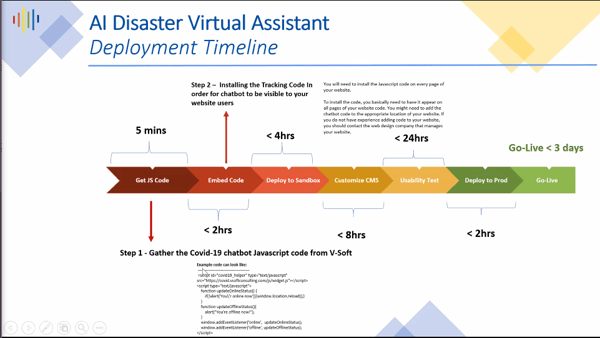During the Coronavirus Pandemic, governments and public institutions are turning to the most advanced technologies available to solve pressing problems. During this Virtual30 presentation IBM's Gökhan Elgün and V-Soft's Konrad Konarski shared how virtual assistants and AI are supporting disaster response efforts today. Gökhan is the lead for IBM Watson chapter that delivers chatbots for internal and external use. Konrad Konarski is the Practice Head for V-Soft's AI and IoT practice and a founding member of the AI Innovation Consortium (AIIC).
AIIC Disaster Chatbot Initiative
The AIIC launched an initiative to allow state and local governments in US and Canada to deploy a chatbot for disaster efforts at no cost using the VERA platform. The difference between static and AI chatbots is that true AI chatbots don't just disseminate information, they import and analyze information to get a pulse on the situation.
During the COVID-19 outbreak, disaster chatbots share critical information such as number of sick people in a single zip code, and gather that information in a single platform to accurately disseminate to the public.
Listen on Spotify: Handling COVID-19 Response With Intelligent Chatbots
Listen on Apple Podcasts: Handling COVID-19 Response With Intelligent Chatbots
COVID-19 Disaster Support Chatbot Features:
- Community Survey
- Location Information
- Static Information
- FAQs
- Emergency Services
Time is of the essence to deploy a reliable communication method such as chatbots. This is the timeline for deploying an AI Chatbot.

AIOPs in Pandemic Response
AIOps within a chatbot is used to analyze various data points. In regard to the Pandemic. AIOps can help people decide which grocery stores to go to by collecting info on which grocery stores don't have a lot of cases or traffic. AI technology uses ITSM triage to recommend and optimize where to get the fastest services possible.
IBM's Work with COVID-19
IBM Watson Assistant leverages cognitive solutions from the IBM Cloud like NLP to respond to questions. Watson Assistant is in use in 20 countries around the world for COVID-19 response. In the back end it's trained to respond to common questions and using Watson Discover, it repeatedly looks for the best response possible to each question. Watson Discover learns as it goes. There are currently more than 85,000 queries and only 10% escalate the chat to a human. IBM Watson Assistant can answer questions like: "What is COVID-19? How do I sanitize my house? How do I protect myself?"
Another AI tool from IBM is the Quantum Experiences a "super computer summit."
Collaborating with energy department to analyze all present data in the world and using quantum computer for fast response. With quantum computing, it's estimated to take 1 or 2 days to train a system to get outcome with ML computing compared to a regular computer which would take 2-3 months.
Chatbots are More Reliable
A common challenge for people is there are so many different sources of information including news media, government sites, open source applications and it's hard to understand which is the most up to date. The general public may not want to do their own research online for fear of getting the wrong info. Chatbots can be used by any degree of technical skills.
How To Ensure Accurate Responses From Chatbots
There are a variety of different back-end and admin tools to approve and edit answers during the deployment and test phase. There is also a dashboard that allows you to see interactions. For example, you may see a lot of people asking about a gas leak, trends in interactions should trigger a real time response.
If you're interested in a COVID-19 Disaster Support chatbot, please email info@aiinnovationconsortium.org.














